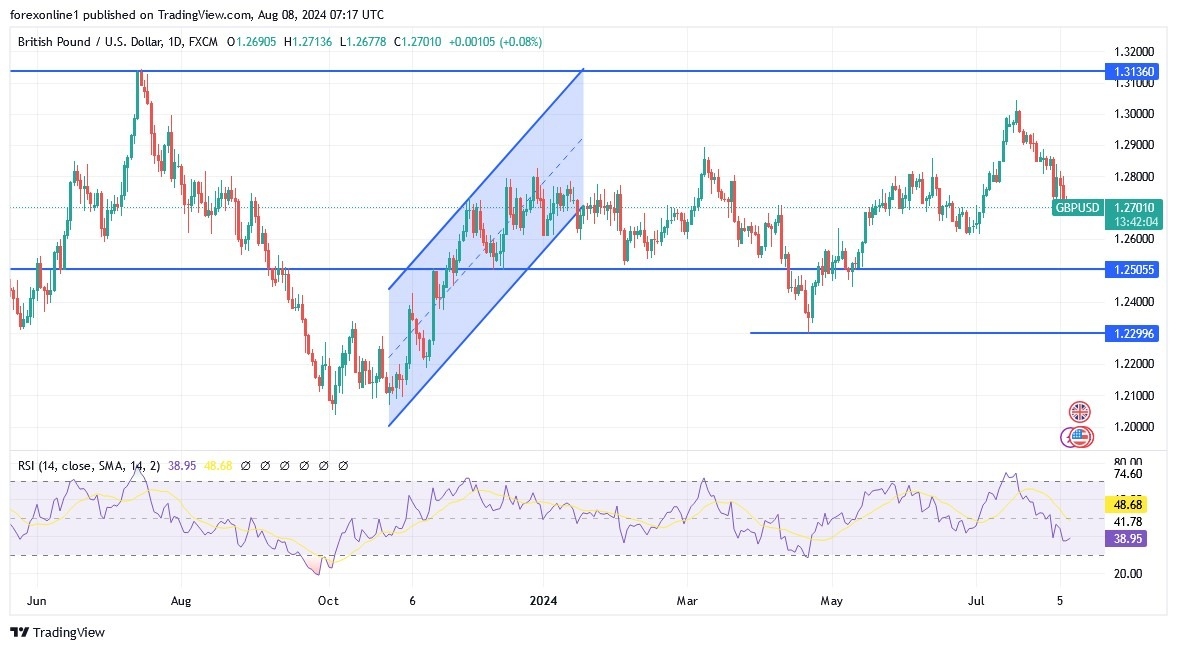- Recently, the global risk-off sentiment has weighed on the British pound in global markets, with aggressive covering of short yen positions.
- Prior to this, the pound benefited from carry trade deals as global investors sold the yen to fund long positions in higher-yielding assets, including the pound.
- Recently, the GBP/USD currency pair plummeted to the 1.2662 support level, its lowest in over a month, and is currently stabilizing around the 1.2695 level at the time of writing this analysis, awaiting any new developments.

Recently, the US jobs data last Friday increased fears that the US economy is sliding into recession. There are also concerns about increasing tensions in the Middle East. According to reliable trading platforms, the British pound against the euro (GBP/EUR) exchange rate recorded further sharp losses to an 11-week low of 1.1660 before recovering slightly to 1.1690 amid increased volatility. The pound was also somewhat affected by the Bank of England’s interest rate cut last week, although the decline in global risk conditions was the main factor. As is well known, the British currency is closely linked to risk trends. When stock markets are strong and there is strong interest in the carry trade, the pound performs well.
However, when conditions deteriorate, the pound comes under pressure.
On the economic side, the Office for National Statistics data showed that the UK economy’s post-pandemic growth was stronger than previously expected. According to revised data from the Office for National Statistics (ONS), the UK economy emerged from the Covid-19 pandemic in a stronger state than previously thought. The new estimates put annual GDP growth for 2022 at 4.8%, up from the previous estimate of 4.3%.
Small revisions to 2020 and 2021 reflect economic adjustments.
The ONS update, released on Wednesday, also includes minor 0.1 percentage point revisions to GDP growth estimates for 2021 and 2020, with previous year figures remaining unchanged. Overall, these revisions reflect a more accurate representation of economic activity, taking into account the full range of administrative and survey data now available to the ONS.
Stronger growth in key sectors drives GDP revision
The updated estimate for 2022, a year marked by rising inflation and market turmoil following Liz Truss's "mini budget", is partly due to stronger growth in the transport, professional, scientific, and technical services industries. The ONS's full dataset provided a clearer picture of the contributions of these sectors to the economy. In addition, the revised figures consider the changing economic structure after the pandemic. The health sector, which saw its share of the economy increase during the pandemic, remained larger in 2022 as the National Health Service worked to address the backlog of care. Analogously, the share of the energy sector in economic activity grew due to rising global oil and gas prices following Russia's invasion of Ukraine.
Hospitality and manufacturing sectors remain affected
By contrast, the hospitality sector, which was severely impacted by Covid-19 lockdowns, remains smaller than it was before the pandemic. The manufacturing sector’s share of output has also fallen, impacted by higher energy prices. Also, the ONS has revised its assessment of the rail and air transport sectors during the pandemic. The rail industry, which received government subsidies to maintain operations, was found to be a bigger drag on growth in 2020 and 2021 than previously thought, as airlines largely ceased operations.
Annual revisions less dramatic than previous years
This year's ONS revisions were less dramatic than those conducted in the previous two years. Last year, the agency's revisions led to a significant reassessment of the UK's economic performance during the pandemic, showing that the economy was more resilient and less of an international outlier than initially thought. Overall, the latest figures reinforce this revised view, suggesting that cumulative GDP growth from 2020 to 2022 was 2.1%, higher than the previous estimate of 1.9%. In September, the ONS will publish figures that will align GDP estimates for 2023 and 2024 with the updated and reweighted data, providing a clearer view of the ongoing economic recovery.
According to stock trading platforms, the FTSE 100 index of UK shares rose 1% on Wednesday, attempting to recover from a recent stock market slump, with most companies posting gains. Heavyweights such as HSBC Holdings and AstraZeneca saw gains of more than 1%, while Shell and BP rose 0.9% and 0.5% respectively, and Unilever rose 0.5%. Housebuilders also performed well, rising more than 1.3% after data revealed a significant rise in house prices in the country in July.
Top Forex Brokers
Technical forecasts for the GBP/USD pair today:
According to the performance on the daily chart, the bearish performance of the GBP/USD price will remain in place and the break of the 1.2600 support confirms the control of the bears and the readiness for stronger losses. Thus, moving the technical indicators towards strong oversold levels. Technically, the pound may remain under pressure from the Bank of England's interest rate cut signals and if the risk-averse sentiment among investors continues as it has been recently. On the other hand, and over the same time frame, the break will be the first downtrend is moving towards the resistance 1.2885.
Ready to trade our Forex daily analysis and predictions? Here are the best forex trading platforms UK to choose from.
